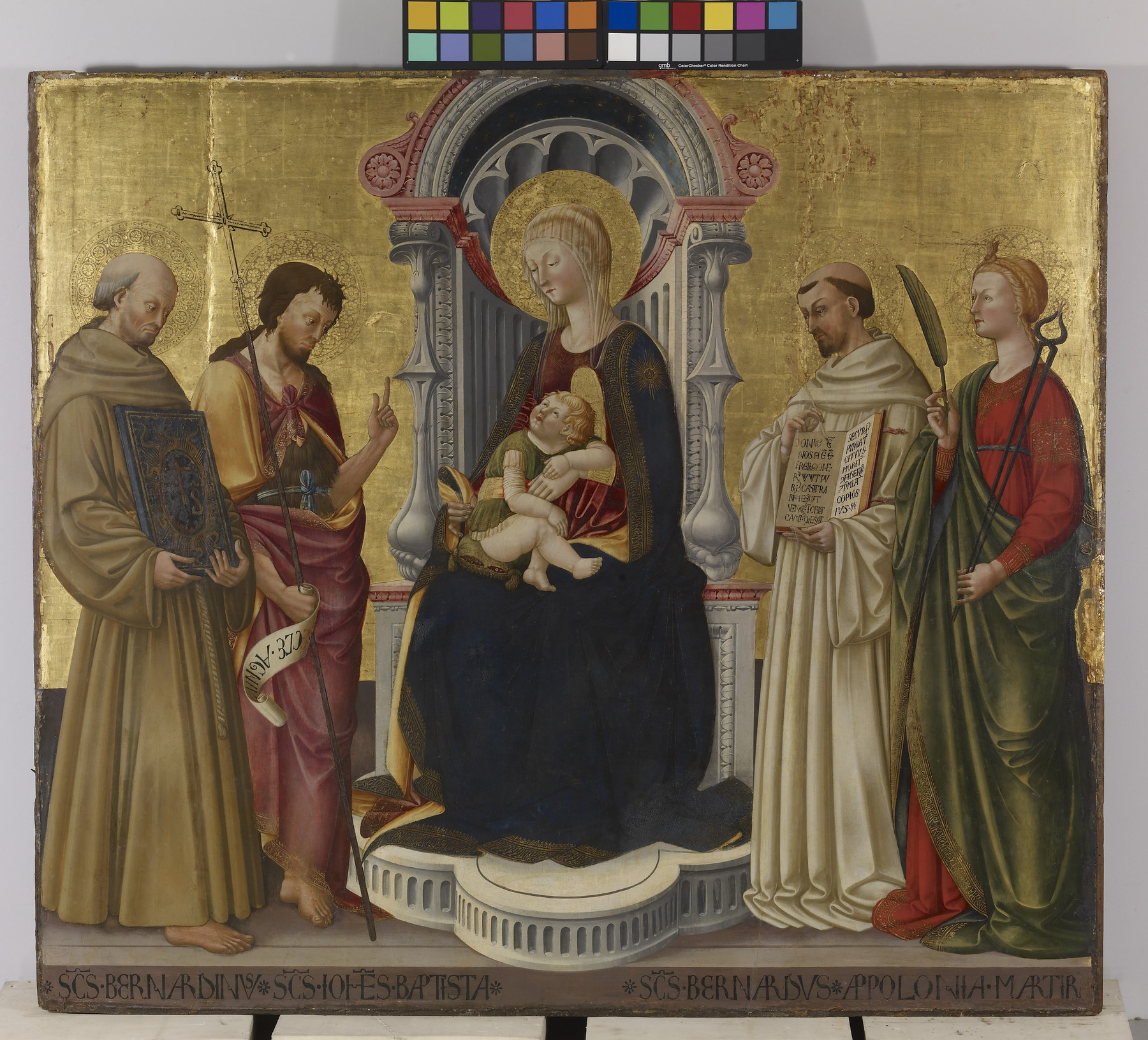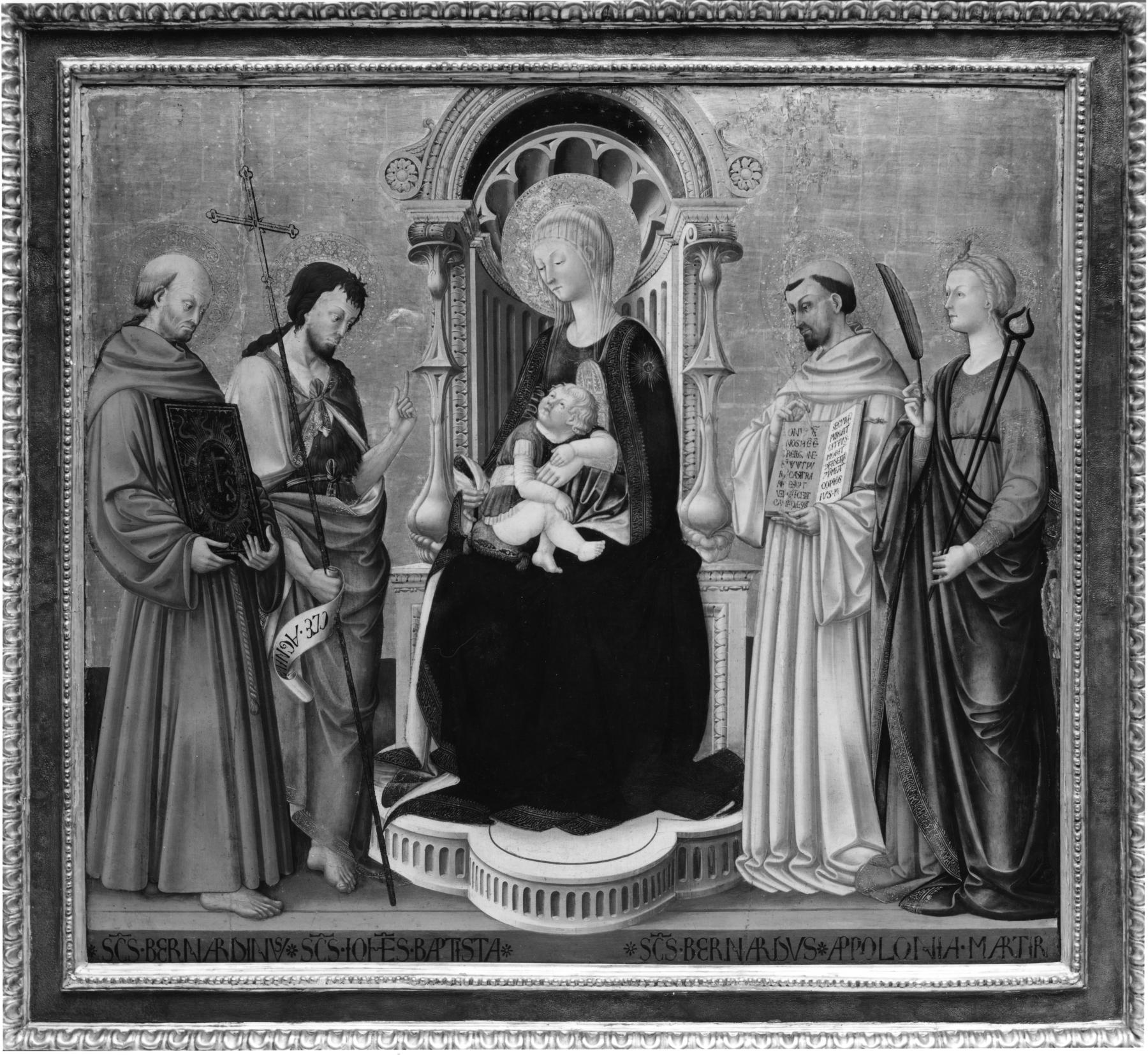Virgin and Child Enthroned with Four Saints
(Renaissance Europe )
This altarpiece follows the convention of a “sacra conversazione,” or “sacred conversation,” meaning that the holy figures are all placed in a unified space that would allow them to talk to one another. At the center is the Virgin and Child, regally seated on an elaborate throne of pink and grey marble. To the left is Saint Bernardino of Siena (1380-1444), holding the tablet emblazoned with the name of Jesus (“YHS”) which he would display to the Sienese public during his famous sermons, and Saint John the Baptist, wearing his typical animal skin shirt and with a staff in the shape of a cross. To the right is Saint Bernard, holding a book inscribed with one of his prayers, and Saint Apollonia, holding a martyr’s palm and pair of pincers clenching a tooth (a reference to the way she was tortured before her martyrdom). To confirm their identities, the saints’ names have been inscribed on the ledge beneath them.
Neri di Bicci operated one of the most successful workshops in Renaissance Florence. He inherited his enterprise from his father, Bicci di Lorenzo (1373-1452), and grandfather, Lorenzo di Bicci (ca. 1350-1427), and recorded all of the workshop’s activities in a diary called the ‘Ricordanze.’ This diary miraculously survives for the years between 1453 and 1475 and provides a remarkable glimpse into the world of a typical Renaissance workshop. This altarpiece does not appear in any of the diary’s entries, suggesting it is one of Neri's earlier works. It certainly dates after 1450, the year in which Bernardino of Siena was officially declared a saint.
Inscription
Provenance
Provenance (from the French provenir, 'to come from/forth') is the chronology of the ownership, custody, or location of a historical object. Learn more about provenance at the Walters.
Savoy Family [date and mode of acquisition unknown] [seal with the shielf of the Savoy family on the reverse of the panel]; Domenico Goretti [date and mode of acquisition unknown] [reverse is inscribed "Collezione Domenico Goretti"]; Alessandro Casati [date and mode of acquisition unknown] [On reverse in ink: "Alessandro Casati" and sticker "No. 3, Casati"]; Marquess Filippo Marignoli, Rome and Spoleto, until 1898 [mode of acquisition unknown]; Marquess Francesco Marignoli, 1898 [mode of acquisition unknown]; Don Marcello Massarenti Collection, Rome, 1899 [mode of acquisition unknown] [1900 catalogue supplement: no. 7, as Allegretto Nuzi]; Henry Walters, Baltimore, 1902, by purchase; Walters Art Museum, 1931, by bequest.
Exhibitions
| 1982 | God's Minstrel: St. Francis of Assisi. The Walters Art Gallery, Baltimore. |
Conservation
| Date | Description | Narrative |
|---|---|---|
| 2/24/1977 | Examination | examined for condition |
| 2/11/1982 | Examination | examined for exhibition |
Geographies
Italy, Florence (Place of Origin)
Measurements
Panel H: 53 15/16 x W: 61 x D: 1 3/16 in. (137 x 155 x 3 cm); Framed H: 63 1/4 x W: 70 3/4 x D: 4 in. (160.66 x 179.71 x 10.16 cm); Painted surface H: 53 3/8 x W: 60 5/8 in. (135.5 x 154 cm)
Credit Line
Acquired by Henry Walters with the Massarenti Collection, 1902
Location in Museum
Not on view
Accession Number
In libraries, galleries, museums, and archives, an accession number is a unique identifier assigned to each object in the collection.
In libraries, galleries, museums, and archives, an accession number is a unique identifier assigned to each object in the collection.
37.700






